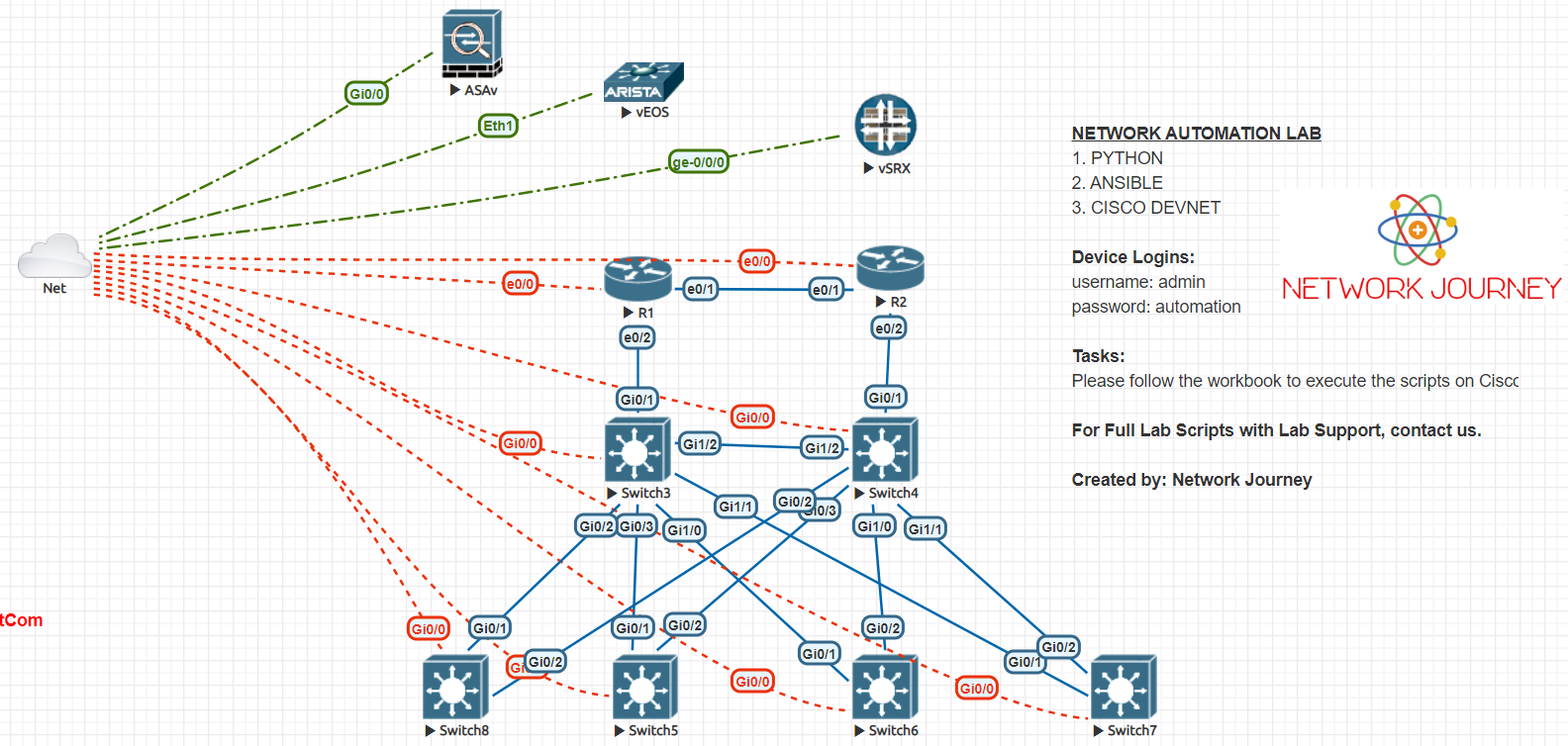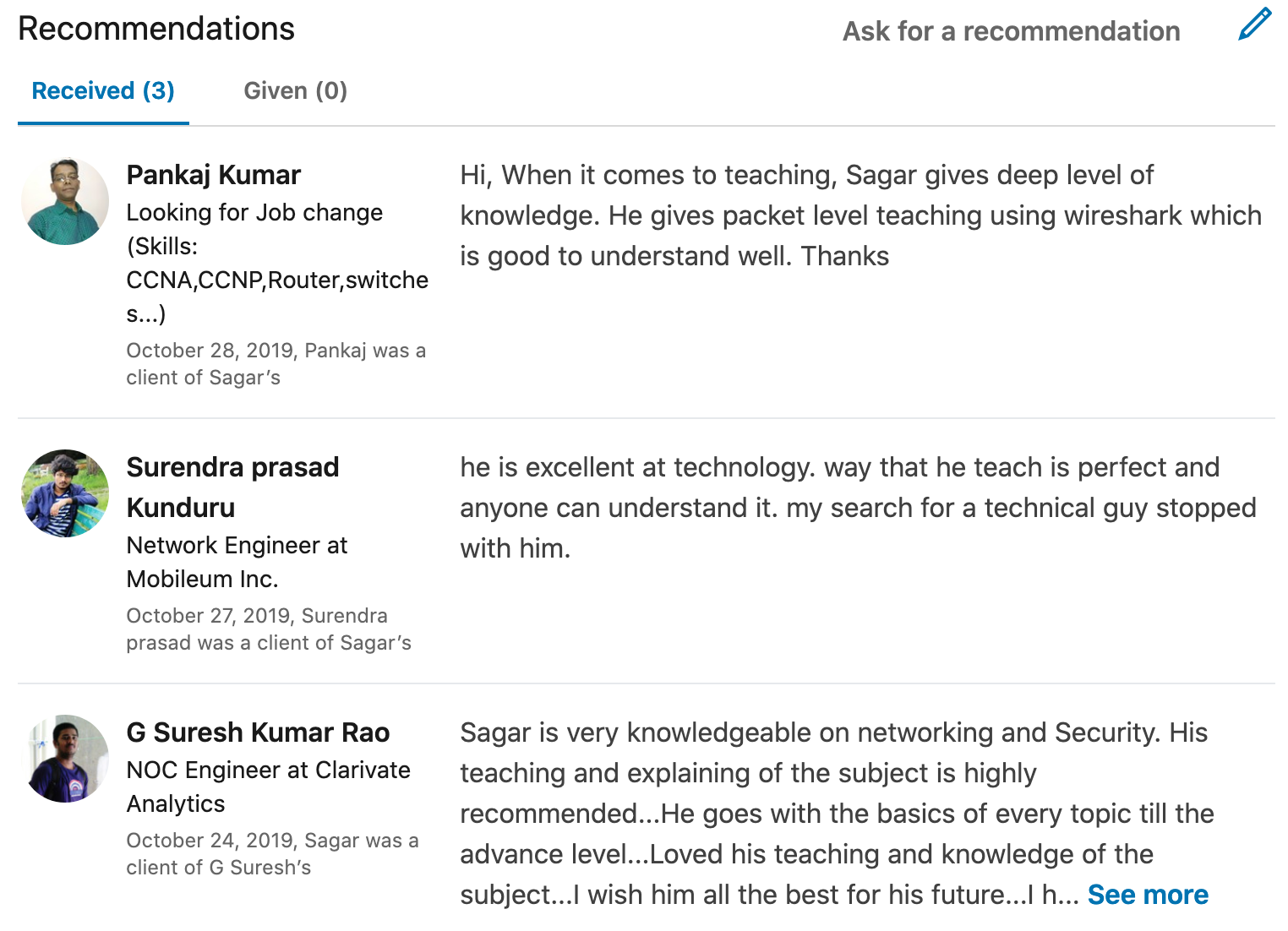CISCO CCNA 200-301
Achieving CCNA certification is the first step in preparing for a career in IT technologies. To earn CCNA certification, you pass one exam that covers a broad range of fundamentals for IT careers, based on the latest networking technologies, software development skills, and job roles.
CCNA gives you the foundation you need to take your career in any direction. The CCNA certification validates your skills and knowledge in network fundamentals, network access, IP connectivity, IP services, security fundamentals, and automation and programmability.


CCNA has been changing lives and shaping the network since 1998. Now, with the recent additions of security and automation, the certification is poised to launch a new generation of IT careers. One of them could be yours.
Why CCNA 200-301:
| Features | Features |
|---|---|
| ● The CCNA certification is accepted all around the world. | ● Professionals armed with the coveted CCNA certificate are entitled to get higher paying jobs when compared to their non-certified counterparts. |
| ● Nowadays, more CCNA jobs are available globally, and to get one easily, possessing the CCNA certificate is a smart choice. CCNA certification processes are enhancing the knowledge base of networking experts – and in many more ways than one! | ● Are you working in an IT firm at present? A CCNA certification would surely increase your chances of getting a promotion. |
| ● You aspire to get more respect from all your co-workers? You can make this dream turn into a reality if you have the CCNA certificate. | ● If you also believe that the Internet will continue dominating the future, then, it is a wise idea to get the CCNA certificate tag on yourself before you start serving the network. |
| ● The knowledge gathered through CCNA can be efficiently used for studying other networking modules; such as CCNA security and CCNA wireless. | ● The CCNA certificate would unquestionably help you switch from your existing job to a better paying and more challenging networking job. |
| ● The knowledge acquired through the CCNA certificate will help you solve more problems in networking. | ● CCNA certification processes are enhancing the knowledge base of networking experts – and in many more ways than one! |
What You Get:
- 40+ Hours – Live Online Instructor-led Training
- Lifetime Access to Web-portal Recordings
- 3 Months – Access to Our Lab Server Rack
- 3 Months – Live Dedicated Trainer Support
- You Learn – CISCO CCNA 200-301
- Instant Access to Recordings after the Live Class
- 24×7 – Home Lab Setup Provided with 100+ Workbook for self practicing
- 10% OFF – Avail additional discount on our next Instructor-led Online Course
- Material: All training Material will be provided in pdf, CLI commands, study material
Course Content – Detailed
- 1.1 Explain the role and function of network components
- 1.1.a Routers
- 1.1.a Routers
- 1.1.c Next-generation firewalls and IPS
- 1.1.c Next-generation firewalls and IPS
- 1.1.e Controllers (Cisco DNA Center and WLC)
- 1.1.f Endpoints
- 1.1.g Servers
- 1.2 Explain the role and function of network components
- 1.1.g Servers
- 1.2.b 3 tier
- 1.2.c Spine-leaf
- 1.2.d WAN
- 1.2.e Small office/home office (SOHO)
- 1.2.f On-premises and cloud
- 1.3.a Single-mode fiber, multimode fiber, copper
- 1.3.b Connections
-
(Ethernet shared media a point-to-point)
- 1.3.c Concepts of PoE
- 1.4 Identify interface and cable issues (collisions, errors, mismatch duplex, and/or speed)
- 1.5 Compare TCP to UDP
- 1.6 Configure and verify IPv4 addressing and subnetting
- 1.7 Describe the need for private IPv4 addressing
- 1.8 Configure and verify IPv6 addressing and prefix
- 1.9.a Global unicast
- 1.9.b Unique local
- 1.9.c Link local
- 1.9.d Anycast
- 1.9.d Multicast
- 1.9.f Modified EUI 64
- 1.10 Verify IP parameters for Client OS (Windows, Mac OS, Linux)
- 1.11.a Nonoverlapping Wi-Fi channels
- 1.11.b SSID
- 1.11.c RF
- 1.11.d Encryption
- 1.12 Explain virtualization fundamentals (virtual machines)
- 1.13.a MAC learning and aging
- 1.13.b Frame switching
- 1.13.c Frame flooding
- 1.13.d MAC address table
- 2.1 Configure and verify VLANs (normal range) spanning multiple switches
- 2.1.a Access ports (data and voice)
- 2.1.b Default VLAN
- 2.1.c Connectivity
- 2.2.a Trunk ports
- 2.2.b 802.1Q
- 2.2.c Native VLAN
- 2.3:Configure and verify Layer 2 discovery protocols (Cisco Discovery Protocol and LLDP)
- 2.4 Configure and verify (Layer 2/Layer 3) EtherChannel (LACP)
- 2.5 Describe the need for and basic operations of Rapid PVST+ Spanning Tree Protocol and identify basic operations
- 2.5.a Root port, root bridge (primary/secondary), and other port names
- 2.5.b Port states (forwarding/blocking)
- 2.5.c PortFast benefits
- 2.6: Compare Cisco Wireless Architectures and AP modes
- 2.7: Describe physical infrastructure connections of WLAN components (AP, WLC,
access/trunk ports, and LAG) - 2.8: Describe AP and WLC management access connections (Telnet, SSH, HTTP, HTTPS,
console, and TACACS+/RADIUS)
- 2.9: Configure the components of a wireless LAN access for client connectivity using GUI only
such as WLAN creation, security settings, QoS profiles, and advanced WLAN settings - 3.1 Interpret the components of routing table
- 3.1.a Routing protocol code
- 3.1.b Prefix
- 3.1.c Network mask
- 3.1.d Next hop
- 3.1.e Administrative distance
- 3.1.f Metric
- 3.1.g Gateway of last resort
- 3.2.a Longest match
- 3.2.b Administrative distance
- 3.2.c Routing protocol metric
- 3.3 Configure and verify IPv4 and IPv6 static routing
- 3.3.a Default route
- 3.3.b Network route
- 3.3.c Host route
- 3.3.d Floating static
- 3.4.a Neighbor adjacencies
- 3.4.b NPoint-to-point
- 3.4.c Broadcast (DR/BDR selection)
- 3.4.d Router ID
- 3.5 Describe the purpose of first hop redundancy protocol
- 4.1 Configure and verify inside source NAT using static and pools
- 4.2 Configure and verify NTP operating in a client and server mode
- 4.3 Explain the role of DHCP and DNS within the network
- 4.4 Explain the function of SNMP in network operations
- 4.5 Describe the use of syslog features including facilities and levels
- 4.6 Configure and verify DHCP client and relay
- 4.7 Explain the forwarding per-hop behavior (PHB) for QoS such as classification, marking,
queuing, congestion, policing, shaping - 4.8 Configure network devices for remote access using SSH
- 4.9 Describe the capabilities and function of TFTP/FTP in the network
- 5.1 Define key security concepts (threats, vulnerabilities, exploits, and mitigation
techniques) - 5.2 Describe security program elements (user awareness, training, and physical access
control) - 5.3 Configure device access control using local passwords
- 5.4 Describe security password policies elements, such as management, complexity, and
password alternatives (multifactor authentication, certificates, and biometrics) - 5.5 Describe remote access and site-to-site VPNs
- 5.6 Configure and verify access control lists
- 5.7 IConfigure Layer 2 security features (DHCP snooping, dynamic ARP inspection, and port
security) - 5.8 Differentiate authentication, authorization, and accounting concepts
- 5.9 Describe wireless security protocols (WPA, WPA2, and WPA3)
- 5.10 Configure WLAN using WPA2 PSK using the GUI
- 6.1 Explain how automation impacts network management
- 6.2 Compare traditional networks with controller-based networking
- 6.3 Describe controller-based and software defined architectures (overlay, underlay, and
fabric) - 6.3.a Separation of control plane and data plane
- 6.3.b North-bound and south-bound APIs
- 6.4 Compare traditional campus device management with Cisco DNA Center enabled device
management - 6.5 Describe characteristics of REST-based APIs (CRUD, HTTP verbs, and data encoding)
- 6.6 Recognize the capabilities of configuration management mechanisms Puppet, Chef, and
Ansible - 6.7 Interpret JSON encoded data
More Preview Before You Buy:
Requirements
- PC or Laptop with internet Connection
- Knowledge on basic Networking Components
Who this course is for:
- CCNA certified Network Engineer
- Network L1, L2, L3 Tier
- Senior Network Engineer
- Network Trainers
- Network Consultant
- Mid-level network engineers
- Network administrators
- Network support technicians
- Help desk technicians
- Interns, Freshers, Graduate
Prerequisites
- There are no formal prerequisites, but you should have a good understanding of the exam topics before taking the exam.
- Students expected to have knowledge in basic Network Fundamentals
Certification
- 200-301 CCNA Exam: Cisco Certified Network Associate | Exam Code: 3200-301 CCNA | Official Exam Price: $300 (USD)
Student Success Feedback


- The passing score is 825/1000.
Requirements
- PC or Laptop with internet Connection
- Basic Knowledge of Networking fundamentals
Features
- No prior knowledge of Checkpoint required. We start from Scratch
- 1.5 Months of Lab access provided
- 40+ Hours Video Content - Lifetime Access
- Live Dedicated Trainer Support - 1.5 Months
- Detailed Course Content Shared Already
Target audiences
- NOC Engineers
- L1, L2, L3, L4 Network Engineers
- Network Engineers
- CCNA, CCNP, CCIE Certified Engineers
- Network security administrators
- Network administrators
- Network analyst
- Network engineers
- Network analyst
- Network consultants